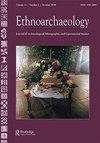玉米啤酒消费的潜在氧同位素特征:一项试验研究
IF 1.3
0 ARCHAEOLOGY
引用次数: 8
摘要
在过去,酒精的消费是一个被广泛研究的主题,主要是因为酒精饮料在许多社会政治制度中扮演着重要的角色。虽然酒精饮料已被广泛认为是社会的重要组成部分,但在古代背景下识别酒精摄入量的能力已被证明是困难的。因此,许多研究古代酒精的作者使用间接指标来重建消费模式。为了建立一种直接的方法,作者进行了一系列的稳定同位素分析,以确定这种方法是否可以用来表明玉米基酒精的存在。本文描述了这一初步研究的结果,并揭示了玉米啤酒的潜在氧同位素特征。我们的数据表明,轻氧同位素优先代表在发酵过程中形成的二氧化碳。因此,得到的饮料比当地水源更富δ18O。这些结果重复并支持了其他玉米啤酒研究人员的类似发现。本文章由计算机程序翻译,如有差异,请以英文原文为准。
A Potential Oxygen Isotope Signature of Maize Beer Consumption: An Experimental Pilot Study
ABSTRACT The consumption of alcohol in the past is a much-studied subject, largely because alcoholic beverages play an important role in numerous sociopolitical institutions. While alcoholic beverages have been widely acknowledged to be an important component of society, the ability to recognize alcohol intake in ancient contexts has proven difficult. As a result, many authors investigating ancient alcohol have used indirect indicators to reconstruct consumption patterns. In an attempt to produce a direct method, the authors conducted a series of stable isotope analyses in order to establish whether this approach can be used to indicate the existence of maize based alcohol. This paper describes the results of this pilot study, and reveals a potential oxygen isotope signature for maize beer. Our data indicate that the light oxygen isotope is preferentially represented in the CO2 formed during fermentation. Thus, the resulting beverage is more δ18O enriched than the local water source. These results replicate and support similar findings from other maize beer researchers.
求助全文
通过发布文献求助,成功后即可免费获取论文全文。
去求助
来源期刊

Ethnoarchaeology
ARCHAEOLOGY-
CiteScore
1.60
自引率
0.00%
发文量
10
期刊介绍:
Ethnoarchaeology, a cross-cultural peer-reviewed journal, focuses on the present position, impact of, and future prospects of ethnoarchaeological and experimental studies approaches to anthropological research. The primary goal of this journal is to provide practitioners with an intellectual platform to showcase and appraise current research and theoretical and methodological directions for the 21st century. Although there has been an exponential increase in ethnoarchaeological and experimental research in the past thirty years, there is little that unifies or defines our subdiscipline. Ethnoarchaeology addresses this need, exploring what distinguishes ethnoarchaeological and experimental approaches, what methods connect practitioners, and what unique suite of research attributes we contribute to the better understanding of the human condition. In addition to research articles, the journal publishes book and other media reviews, periodic theme issues, and position statements by noted scholars.
 求助内容:
求助内容: 应助结果提醒方式:
应助结果提醒方式:


